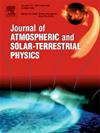Advanced detection methods and machine learning analysis of temporal and spatial patterns of equatorial plasma bubble depth
IF 1.8
4区 地球科学
Q3 GEOCHEMISTRY & GEOPHYSICS
Journal of Atmospheric and Solar-Terrestrial Physics
Pub Date : 2025-03-13
DOI:10.1016/j.jastp.2025.106495
引用次数: 0
Abstract
Strong plasma density depletions, particularly across broader longitudinal areas with consecutive depletion trains, are challenging to analyse using simple polynomial fitting or moving average techniques for detrending. This study presents a double threshold approach, combining the “Bubble Index” and the “Rolling Barrel Technique,” to detect the depth of plasma irregularities. The proposed method is promising in EPB characterization and depth estimation. We validated the result from our method by analysing the temporal, seasonal, and longitudinal characteristics of Equatorial Plasma Bubbles (EPBs) using data for solar cycle 24 from the Communication/Navigation Outage Forecasting System (C/NOFS), covering about 8 years (August 2008–November 2015). Our Machine Learning (ML) prediction results show that XGBoost outperforms other approaches (Random Forest and LSTM), achieving skill, association, and root mean square error scores of 0.78, 0.88, and 0.14, respectively. Climatological verifications of our analysis show that most EPB events are concentrated between −70° and −30° longitude in the South Atlantic Anomaly (SAA). The depth magnitude of EPBs is inversely proportional to altitude, with shallower depths observed during solar minimum and deeper depths during periods of moderate solar activity. Postsunset bubbles are quite deeper, especially between 19:00 LT and 21:00 LT, having significantly deeper magnitude during equinoxes and shallowest in summer, particularly over South America. As the satellite's apex lowered, the depths of postsunset and postmidnight EPB became nearly equal, highlighting the importance of observation altitude. Analysing EPB depth variation with location and time will enhance understanding of EPB dynamics by identifying how seasonal and solar activity influences EPB formation patterns. These findings will further aid in developing improved ionospheric models for space weather forecasting.
赤道等离子体气泡深度时空格局的先进探测方法与机器学习分析
使用简单的多项式拟合或移动平均技术进行去趋势分析是具有挑战性的,特别是在具有连续耗尽序列的较宽纵向区域。本研究提出了一种双阈值方法,结合“气泡指数”和“滚动桶技术”来检测等离子体不规则性的深度。该方法在EPB表征和深度估计方面具有较好的应用前景。利用通信/导航中断预报系统(C/NOFS)第24太阳周期(2008年8月至2015年11月)的数据,通过分析赤道等离子体气泡(EPBs)的时间、季节和纵向特征,验证了本文方法的有效性。我们的机器学习(ML)预测结果表明,XGBoost优于其他方法(随机森林和LSTM),分别实现了0.78、0.88和0.14的技能、关联和均方根误差得分。对分析结果的气候学验证表明,大多数EPB事件集中在南大西洋异常(SAA)的- 70°和- 30°经度之间。epb的深度大小与海拔高度成反比,在太阳极小期观测到的深度较浅,在太阳中度活动期间观测到的深度较深。日落后的气泡相当深,特别是在19:00至21:00之间,在春分时明显更深,在夏季最浅,特别是在南美洲。随着卫星顶点的降低,日落后和午夜后EPB的深度几乎相等,突出了观测高度的重要性。分析EPB深度随地点和时间的变化将通过确定季节和太阳活动如何影响EPB形成模式来增强对EPB动力学的理解。这些发现将进一步有助于开发用于空间天气预报的改进电离层模型。
本文章由计算机程序翻译,如有差异,请以英文原文为准。
求助全文
约1分钟内获得全文
求助全文
来源期刊

Journal of Atmospheric and Solar-Terrestrial Physics
地学-地球化学与地球物理
CiteScore
4.10
自引率
5.30%
发文量
95
审稿时长
6 months
期刊介绍:
The Journal of Atmospheric and Solar-Terrestrial Physics (JASTP) is an international journal concerned with the inter-disciplinary science of the Earth''s atmospheric and space environment, especially the highly varied and highly variable physical phenomena that occur in this natural laboratory and the processes that couple them.
The journal covers the physical processes operating in the troposphere, stratosphere, mesosphere, thermosphere, ionosphere, magnetosphere, the Sun, interplanetary medium, and heliosphere. Phenomena occurring in other "spheres", solar influences on climate, and supporting laboratory measurements are also considered. The journal deals especially with the coupling between the different regions.
Solar flares, coronal mass ejections, and other energetic events on the Sun create interesting and important perturbations in the near-Earth space environment. The physics of such "space weather" is central to the Journal of Atmospheric and Solar-Terrestrial Physics and the journal welcomes papers that lead in the direction of a predictive understanding of the coupled system. Regarding the upper atmosphere, the subjects of aeronomy, geomagnetism and geoelectricity, auroral phenomena, radio wave propagation, and plasma instabilities, are examples within the broad field of solar-terrestrial physics which emphasise the energy exchange between the solar wind, the magnetospheric and ionospheric plasmas, and the neutral gas. In the lower atmosphere, topics covered range from mesoscale to global scale dynamics, to atmospheric electricity, lightning and its effects, and to anthropogenic changes.
 求助内容:
求助内容: 应助结果提醒方式:
应助结果提醒方式:


